Greenhouse Gas Emissions in Agriculture
By Mark Jeschke, Ph.D., Agronomy Manager
By Mark Jeschke, Ph.D., Agronomy Manager
Efforts to reduce greenhouse gas emissions have brought increased attention to the role of agriculture, both as a source of greenhouse gas emissions and for potential strategies within the industry for sequestering emissions. With the rapid expansion of carbon credit programs and other initiatives aimed at reducing agriculture’s climate impact, it is important to understand how agriculture contributes to greenhouse gas emissions, where the greatest opportunities lie for reducing those emissions, and how agriculture fits into the wider effort to drawdown greenhouse gas emissions.
Agricultural production is both a source and sink for greenhouse gases. Numerous processes in involved in crop and livestock production release carbon dioxide and other greenhouse gases into the atmosphere. Crop production also captures carbon dioxide from the atmosphere through photosynthesis. Management practices such as conservation tillage and cover crops can help increase the amount of that captured carbon that is stored in the soil. On balance though, agriculture is a net emitter of greenhouse gases, with the quantity emitted through various processes far exceeding the quantity stored (Figure 1).
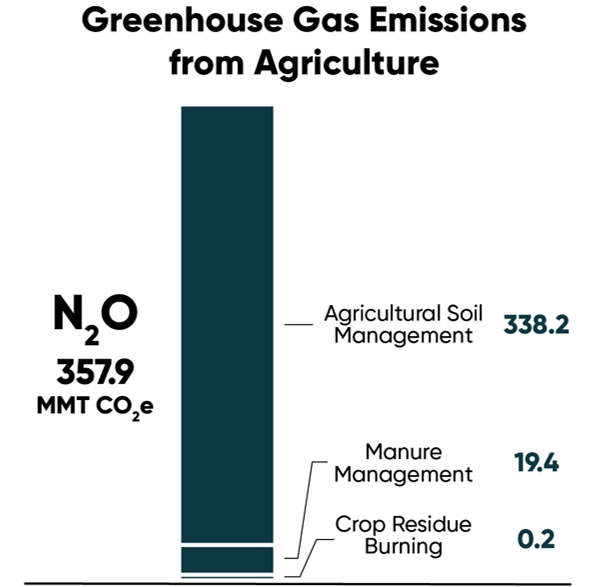
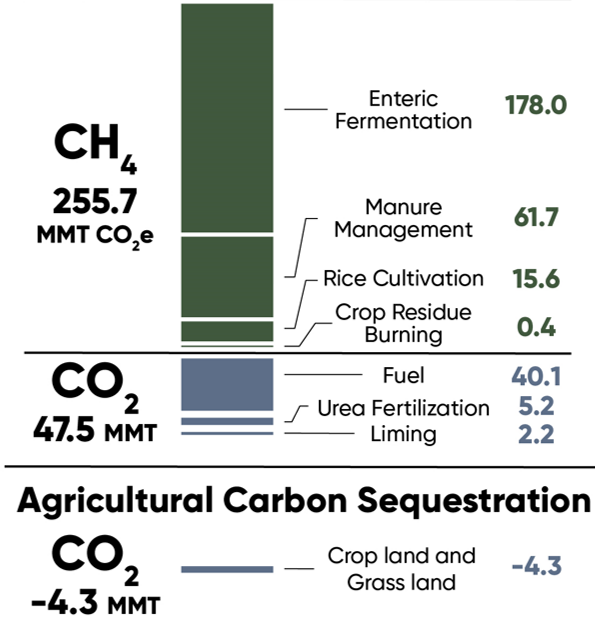
Figure 1. Greenhouse gas emissions from agriculture and sequestration in crop and grass land in the U.S., 2018. (Source: EPA Inventory of U.S. Greenhouse Gas Emissions and Sinks 1990-2019.)
Agriculture accounts for around 10% of U.S. greenhouse gas emissions according to the U.S. Environmental Protection Agency (EPA), making it a significant contributor, but not nearly as large as the top three sectors: transportation (28%), electricity generation (27%), and industry (22%) (Table 1).
Table 1. U.S. greenhouse gas emissions by economic sector, 2018. (Source: Inventory of U.S. Greenhouse Gas Emissions and Sinks 1990-2019, Table ES-6).
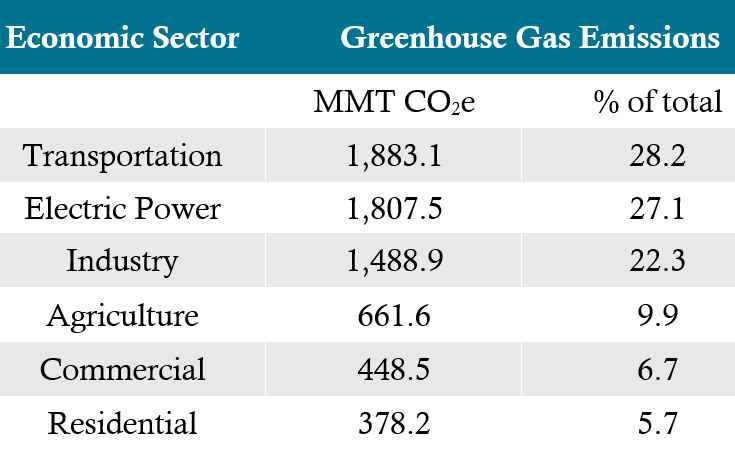
Estimates of greenhouse gas emissions attributable to agriculture vary widely though, and figures produced by other organizations are often higher than the EPA estimate of 10%. For example, the U.N. Food and Agriculture Organization (FAO) estimates that 17% of anthropogenic greenhouse gas emissions are attributable to agriculture (FAO, 2020). The World Resources Institute estimates that agriculture and land use change, which is primarily driven by agriculture, collectively account for nearly 24% of greenhouse gas emissions (Arcipowska et al., 2019). Discrepancies in these estimates can sometimes become contentious when evaluating where attention, resources, and regulations for reducing greenhouse gas emissions should be prioritized.
There are a few reasons why estimates of agriculture’s contribution to greenhouse gas emissions vary so widely:
Efforts to reduce greenhouse gas emissions associated with the global food production system have prioritized a few key areas spanning across food production, supply chains, and consumption that offer the greatest opportunity for emissions reduction (Ritchie, 2021):
Two of these five areas, higher yields and better management practices relate directly to how food is produced, so are key areas of focus for improving agricultural production systems.
The urgent need to reduce greenhouse gas emissions while continuing to increase production to feed a growing global population is one of the most important challenges facing agriculture today. The first step in meeting that challenge is understanding how and where greenhouse gases are being emitted from agricultural systems.
Efforts to reduce greenhouse gas emissions have most commonly focused on carbon dioxide. Across all economic sectors, carbon dioxide is the predominant anthropogenic greenhouse gas, accounting for 79% of emissions, followed by methane (11%), nitrous oxide (7%), and fluorinated gases (3%). In the agriculture sector, however; carbon dioxide comprises only 7% of emissions, with 54% coming from nitrous oxide and 39% from methane.
Total greenhouse gases emissions are often expressed as CO2 equivalent units (CO2e or CO2-eq) which allows different greenhouse gases to be combined into a single metric while accounting for the differing global warming potential of the different gases. For example, the global warming potential of methane is 25, meaning it has 25 times the heat trapping efficiency as CO2. Nitrous oxide is an even more powerful greenhouse gas with a global warming potential of 298.
Major Sources and Sinks
The largest sources of agricultural greenhouse gas emissions in the U.S. are nitrous oxide emissions from agricultural soils and methane emissions from livestock production (enteric fermentation and manure). Methane from rice production is also a major contributor to agricultural greenhouse gas emissions globally, but not as much in the U.S. since rice is not a major U.S. crop. Contributions of agricultural emission sources compared to other major sources of methane and nitrous oxide are shown in Figure 2.
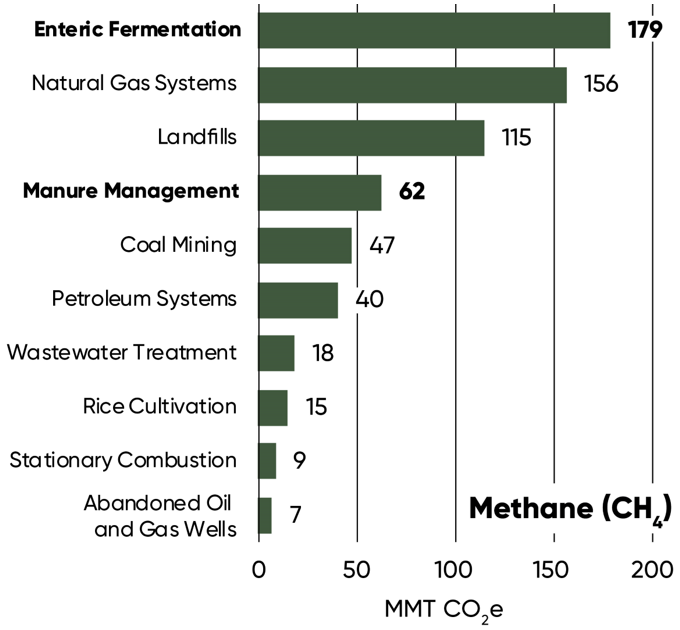
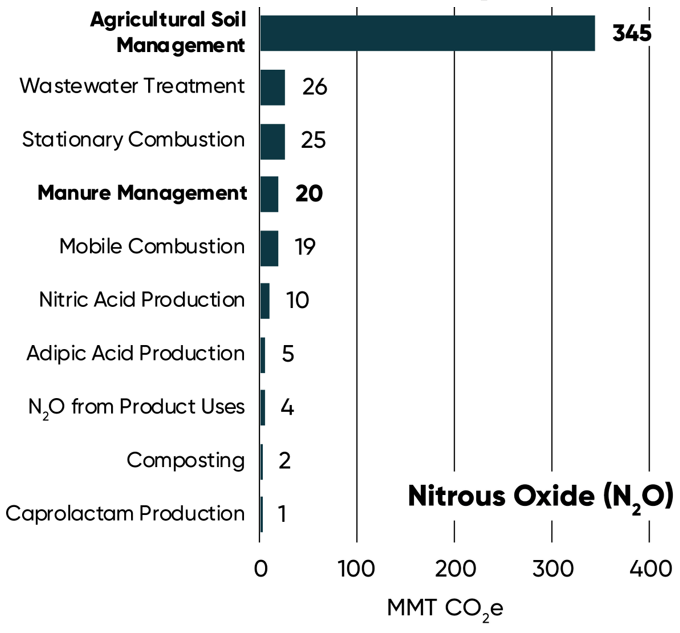
Figure 2. Major sources of methane (top) and nitrous oxide (above) emissions in the U.S. (Source: EPA Inventory of U.S. Greenhouse Gas Emissions and Sinks 1990-2019.)
Agricultural production is a source of greenhouse gas emissions, but it can also serve as a greenhouse gas sink by removing carbon dioxide from the air. Plants take in carbon dioxide and incorporate it into plant tissues via photosynthesis. A portion of this carbon can remain in the soil as soil organic carbon. Management practices that favor the buildup or soil organic carbon over time can sequester carbon in the soil and offset a portion of greenhouse gas emissions. However, the quantity of carbon dioxide sequestered in agricultural soils is relatively small. Net carbon dioxide sequestered in agricultural crop and grass land offsets less than 1% of the total greenhouse gases emitted by agriculture (U.S. EPA, 2021).
Overall greenhouse gas emissions in the U.S. have declined over the past 15 years. Total greenhouse gas emissions in the U.S. peaked in 2007 at 7,464 MMT CO2e and have fallen by about 13% since then. This downward trend has largely been due to emissions reductions in industry and electricity generation. Agricultural emissions, on the other hand, have continued to increase, rising by about 4% over the same period. Emissions from the agriculture sector have increased steadily over the past 30 years by around 1.9 MMT CO2e per year (Figure 3).
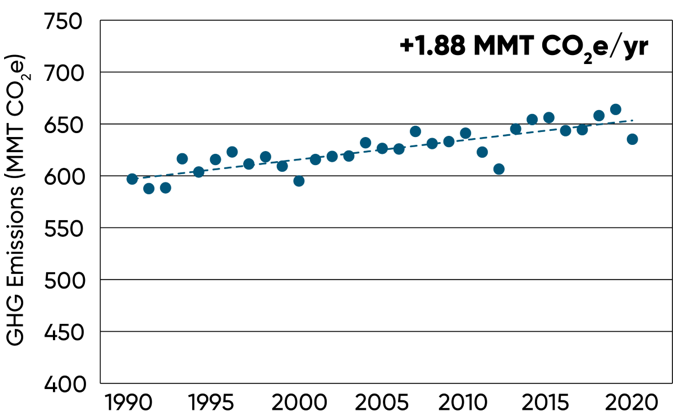
Figure 3. Recent trend in greenhouse gas emissions from the U.S. agriculture sector, 1990-2020. (Source: EPA Inventory of U.S. Greenhouse Gas Emissions and Sinks 1990-2019.)
While greenhouse gas emissions from agriculture have continued to increase, agricultural productivity has increased at an even faster rate, meaning that emissions per unit of production have gone down for most major commodities in the U.S. This is a noteworthy accomplishment – U.S. agriculture has been able to greatly increase output without concomitant increases in inputs or land use. However, meeting the emissions targets necessary to avoid the most severe climate impacts means that emissions across all economic sectors, including agriculture, need to be reduced.
The majority of anthropogenic greenhouse gas emissions come from the burning of fossil fuels (coal, oil, and gas) for energy. Consequently, this is where the most urgency for reducing emissions has been focused and it tends to be dominant lens through which we view the issue. However, emissions associated with agricultural processes differ in some important ways that are relevant for how we think about managing them.
Natural vs. Artificial Processes
The burning of fossil fuels involves extracting deposits of hydrocarbons locked deep in the Earth’s crust and, through combustion, releasing the carbon back into active circulation in Earth’s carbon cycle. This process is entirely the product of human intervention – there are many natural processes that continually cycle carbon in and out of the atmosphere; however, fossil fuel burning is an artificial process that has been added to the system. Consequently, when setting targets for greenhouse gas reductions, the goal for fossil fuel emissions ultimately needs to be zero – the complete elimination of oil, gas, and coal as sources of energy.
Many of the greenhouse gas emissions associated with agriculture, on the other hand, come from natural processes. Methane and nitrous oxide are naturally produced by animals and soil bacteria, and production of these gases would still be going on without any human intervention. What is “unnatural” is the scale at which these processes are now occurring. The massive expansion of agricultural activity around the world that has accompanied population growth over the past century has amplified these processes to a degree that it has created persistent imbalances in the global nitrogen and methane cycles, resulting in rising atmospheric concentrations of both (Duglokencky, 2022; Elkins et al., 2022). Completely eliminating these emissions sources is not possible or even desirable, so efforts need to be focused on finding areas in agricultural systems where emissions can be reduced to a degree that will help bring these natural cycles back into balance.
Residence Time of Gases in the Atmosphere
Agricultural greenhouse gas emissions are primarily in the form of nitrous oxide and methane, which both have a much greater warming effect than carbon dioxide, but also do not persist as long in the atmosphere.
The urgency surrounding elimination of fossil fuel emissions is partly due to the vast quantities of carbon dioxide being emitted, but also due to the persistence of carbon dioxide in the atmosphere. A significant fraction of the carbon dioxide being emitted today will remain in the atmosphere for a thousand years or more (Archer and Brovkin, 2008). This means that, even if net zero carbon dioxide emissions could be achieved immediately, the warming impact of carbon dioxide that has already been emitted will continue to be felt for centuries. This is why the elimination of fossil fuel emissions is such a critical goal.
Nitrous oxide, and especially methane, have shorter residence times in the atmosphere; 121 years in the case of nitrous oxide and 12.4 years for methane (U.S. EPA, 2022). Since they do not accumulate in the atmosphere in the same way as carbon dioxide, there is greater potential for achieving an equilibrium concentration where ongoing emissions can be offset by natural atmospheric removals. And if emissions can be eliminated, their climate impact will be gradually reversed rather than persisting for centuries or millennia like that of carbon dioxide (Lynch et al., 2021). Atmospheric concentrations of both gases continue to rise due to anthropogenic emissions and reductions in both are critical for meeting climate goals, but their long-term impact is not the same as that of carbon dioxide.
The two largest sources of greenhouse gas emissions in U.S. agriculture are nitrous oxide emissions from agricultural soils and methane emissions from livestock production. Consequently, these two areas offer the greatest opportunity for reducing total agricultural emissions.
Agricultural Soil Management
Nitrous oxide emissions categorized under agricultural soil management include emissions from land in crop production as well as managed grass lands (Figure 4). Nitrous oxide is naturally produced in soils through the microbial processes of nitrification and denitrification. These processes are driven by the availability of mineral nitrogen (NH4+ and NO3-) in the soil. Mineral nitrogen is made available via natural processes such as decomposition of soil organic matter and plant material, and by asymbiotic nitrogen-fixing bacteria.
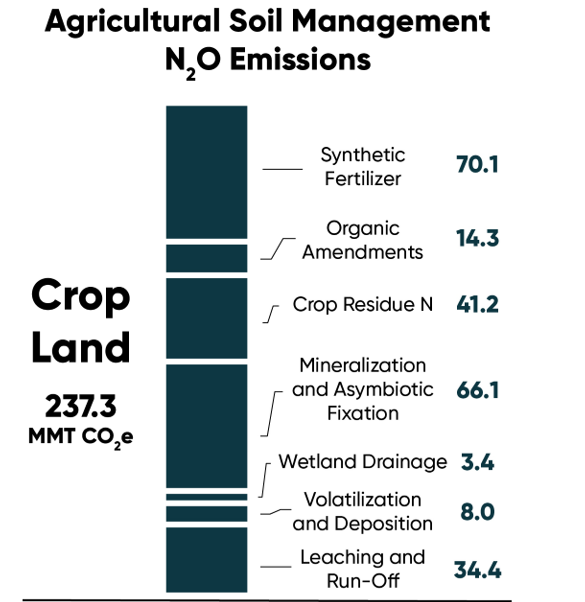
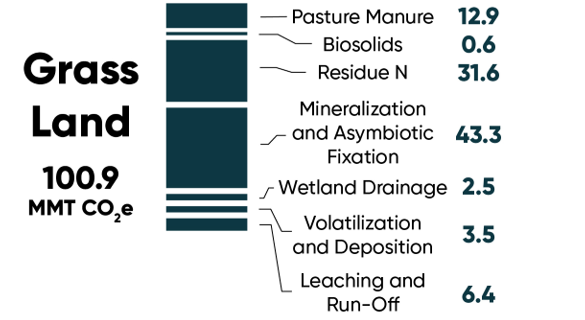
Figure 4. Direct and indirect nitrous oxide emissions from agricultural soils by land type. (Source: EPA Inventory of U.S. Greenhouse Gas Emissions and Sinks 1990-2019.)
The majority of nitrous oxide emissions from soils are produced during denitrification, in which nitrate (NO3–) is converted to N2 gas. When nitrate is not completely converted to N2 gas, the resulting byproduct is nitrous oxide (N2O). Denitrification occurs when oxygen availability is limited in the soil due to water saturation. Nitrous oxide emissions from denitrification are triggered by rainfall events of sufficient volume to saturate at least 60% of soil pore space. Lesser amounts of nitrous oxide are produced during nitrification, which is the conversion of ammonium to nitrate.
Several agricultural activities increase nitrous oxide emissions beyond what would occur naturally by increasing the amount mineral nitrogen in the soil. The most significant of these activities is adding mineral nitrogen to the soil via synthetic fertilizers. Additionally, agricultural soil management activities such as irrigation, drainage, and tillage can increase the rate of nitrogen mineralization and asymbiotic nitrogen fixation occurring in the soil, which can also increase nitrous oxide emissions.
Nitrous oxide emissions attributed to agricultural soil management also include indirect emissions, which occur when nitrogen that moves off of agricultural land is subsequently converted to nitrous oxide. This includes volatilization and subsequent deposition of applied or mineralized nitrogen, as well as surface runoff and leaching of nitrogen into groundwater and surface water.
Agricultural soil management emissions are subdivided by crop land and grass land, the latter of which includes both pastures and native rangelands. Crop land accounts for around 2.3 times the total amount of nitrous oxide emissions as grass land; however, the land area in the U.S. categorized as grass land is far larger. On a per acre basis, emissions from crop land are closer to 5 times those of grass land.
Reducing Nitrous Oxide Emissions
The most important step in reducing nitrous oxide emissions from crop production is increasing nitrogen use efficiency, which is the fraction of applied nitrogen that is harvested as product. Globally, less than half of nitrogen applied to crop land is taken up by the crop (Zhang et al., 2015) with most of the rest lost to the environment. Not only is this economically wasteful, the loss of reactive nitrogen from agricultural soils is associated with several adverse environmental consequences, including contamination of ground and surface water, algal blooms in lakes and rivers, hypoxic dead zones in coastal waters, and nitrous oxide emissions into the atmosphere.
Opportunities and strategies for improving nitrogen use efficiency vary widely around the world due to differences in crops and agronomic management. The greatest need for improvement is in China and India, both of which use large amounts of nitrogen fertilizer and have very low nitrogen use efficiency, at around 30%. This low efficiency is partly due to overapplication of fertilizer but also due to lower nitrogen use efficiency of crops commonly grown there.
Nitrogen use efficiency in the U.S. is relatively high, at around 70%, and has improved in recent decades from around 60% in 1990 (Lassaletta et al., 2014). Increased efficiency in the U.S. is largely attributable to improvements in genetics and management that have resulted in greater yield stability and, consequently, a greater likelihood that applied nitrogen will be taken up by the crop (Ciampitti and Vyn, 2014; DeBruin et al., 2017). However, despite higher nitrogen use efficiency in the U.S., nitrous oxide emissions from agricultural soils have continued to go up, increasing by around 6% since 1990. The reductions in nitrogen loss from greater efficiency have been more than offset by an increase in total nitrogen applied.
Reducing nitrous oxide emissions will require further improvements in nitrogen use efficiency. Nitrous oxide emissions can effectively be reduced by reducing or minimizing the concentration of inorganic nitrogen in soils, especially during periods when denitrification or nitrification are most likely to occur. The trend toward increased volume and intensity of rainfall events during the spring in the U.S. Corn Belt will make it increasingly important to manage nitrogen to avoid losses during this time.
Several management practices and technologies may help reduce nitrous oxide emissions from soils (Millar et al. 2014, adapted from Cavagelli et al., 2012):
Nitrogen Application Rate: Optimizing application rates may reduce nitrous oxide emissions substantially where nitrogen fertilizer is applied at rates greater than the economic optimum rate.
Nitrogen Fertilizer Source: Nitrogen sources include urea, anhydrous ammonia, urea ammonium nitrate, ammonium nitrate and manure. Slow-release fertilizers, such as polycoated urea, are not widely used because of increased costs. Urea, urea ammonium nitrate, and polycoated ureas can decrease nitrous oxide emissions by 50% or more compared with anhydrous ammonia in some locations, but research has shown no impact in other locations.
Nitrogen Fertilizer Placement: Nitrogen fertilizer may be broadcast or applied in bands, applied on the surface or below the surface (such as manure). Incorporating bands of nitrogen in soil can improve nutrient use efficiency and can reduce nitrous oxide emissions by about 50% compared with broadcast application in some locations.
Nitrogen Application Timing: Nitrogen fertilizer should be applied as close as possible to when the crop needs it. Applying nitrogen at planting or at times of peak crop nitrogen demand can increase nutrient use efficiency and would be expected to decrease nitrous oxide emissions; however, results from field studies are mixed.
Nitrification and Urease Inhibitors: Can decrease nitrous oxide emissions by 50% in dry climates, but results have been mixed for humid climates.
Cover Crops: Winter cover crops can reduce nitrogen losses due to leaching and runoff but may not affect direct nitrous oxide emissions.
Improved Irrigation Management: Reducing application rates to minimize soil wetness can reduce nitrous oxide emissions. Subsurface drip irrigation can reduce nitrous oxide emissions compared with overhead sprinkler irrigation because soil moisture is better regulated, but data are limited.
Reduced Tillage: A long-term no-till strategy has been shown to reduce nitrous oxide emissions by up to 50% but data are limited. Short-term no-till results are more mixed.
Methane Emissions from Livestock
Methane from livestock production comes primarily from enteric fermentation (74%) and manure (26%) (Figure 5). Enteric fermentation is the process by which microbes in an animal’s digestive system ferment food consumed by the animal during digestion. Methane is produced as a byproduct and is either exhaled or belched out of the animal. The amount of methane produced and emitted depends primarily upon the animal's digestive system, and the amount and type of feed it consumes.
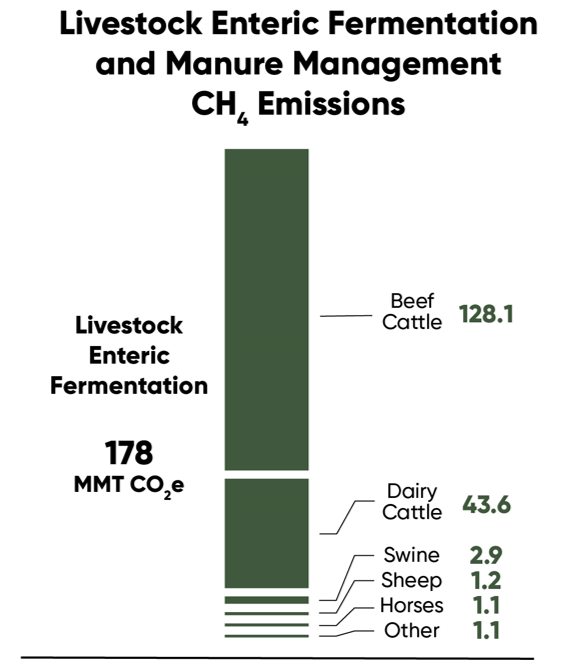
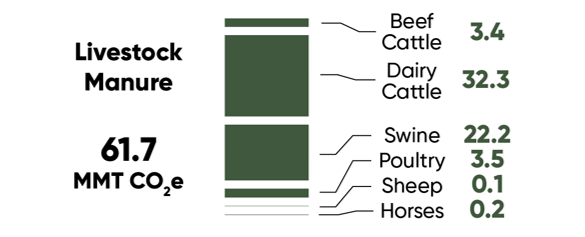
Figure 5. Methane emissions from livestock enteric fermentation and manure management by livestock type. (Source: EPA Inventory of U.S. Greenhouse Gas Emissions and Sinks 1990-2019.)
Ruminant animals, such as cattle, goats, and sheep, emit methane at a much higher rate because of their unique digestive systems. Ruminants have a large fore-stomach (rumen) in which microbial fermentation breaks down the feed they consume into products that can be absorbed and metabolized. The microbial fermentation that occurs in the rumen enables them to digest complex carbohydrates from plants, such as cellulose and hemicellulose, that non-ruminant animals cannot digest. Non-ruminant animals also produce methane emissions through enteric fermentation; however, microbial fermentation in non-ruminants occurs in the large intestine and at a much lower rate. Methane emissions are also affected by feed intake and quality. Larger animals such as cattle produce more methane because of their higher feed intake.
Methane can also be emitted by livestock manure. Methane is produced when manure is stored or treated in systems that create anaerobic conditions, such as lagoons or pits. Bacteria convert organic wastes into volatile acids, which are then converted into methane by a type of archaea known as methanogens. Since this process only occurs under anaerobic conditions, how manure is stored and handled can greatly affect how much methane is produced. When manure is handled as a solid or deposited in a pasture by grazing animals, it tends to decompose aerobically and produce little or no methane. The shift toward larger confinement livestock operations in which manure is handled as a liquid and stored for longer periods of time has resulted in increased methane emissions compared to traditional, smaller livestock farms where manure was often hauled and spread daily.
The majority of methane emissions from livestock come from beef and dairy cattle due to the high amount of methane produced through enteric fermentation (Figure 5). Methane emissions via enteric fermentation from non-ruminant animals are relatively low. Methane emissions from manure are largely associated with dairy and swine production, due to the prevalence of liquid manure storage and handling systems on these types of operations.
Management to Reduce Methane Emissions
Advances in manure handling systems that can reduce methane emissions are already being deployed and offer the opportunity for greater reductions in emissions as they become more prevalent.
Solid-Liquid Separation: Separating the solid and liquid components of manure is a relatively simple tactic that reduce methane emissions. The solid portions of manure are drier after separation, eliminating the anaerobic conditions that favor methane production. The liquid fraction will also produce fewer emissions because methane-producing microorganisms have less organic matter to feed on.
Methane Digesters: Methane digesters are systems thatccapture methane released from liquid manure and burn it to produce heat or electricity. By replacing fossil fuels that would otherwise be used to produce the same amount of heat or electricity, the digesters result in a net greenhouse gas benefit. Digester systems can also help reduce odor and disease-causing pathogens.
Reducing methane emissions from enteric fermentation has proven more difficult. Approaches at reducing emissions have included animal breeding, vaccines, drugs, and feed additives. The majority of results have been unsuccessful though, due to the ability of the digestive microorganism populations to adapt over time to tactics aimed at suppressing them.
Recent research into feed additives has been much more promising, however. Research has shown that supplementation with a type of red seaweed (Asparagopsis taxiformis) can reduce enteric methane production in beef cattle by over 80%, while allowing the cattle to use a greater proportion of the energy in their feed (Roque et al., 2021).
The foregoing is provided for informational use only. Please contact your Pioneer sales professional for information and suggestions specific to your operation. Product performance is variable and depends on many factors such as moisture and heat stress, soil type, management practices and environmental stress as well as disease and pest pressures. Individual results may vary. Pioneer® brand products are provided subject to the terms and conditions of purchase which are part of the labeling and purchase documents.
